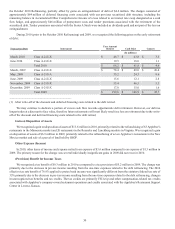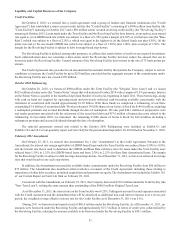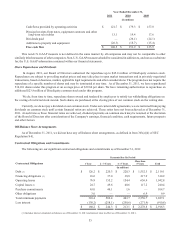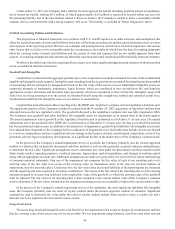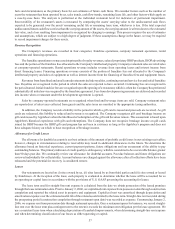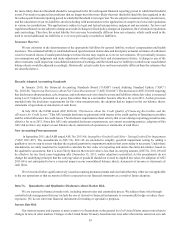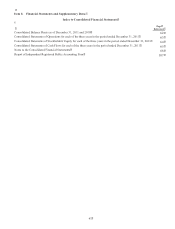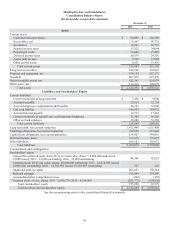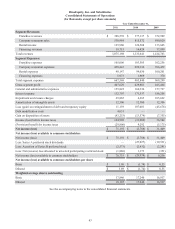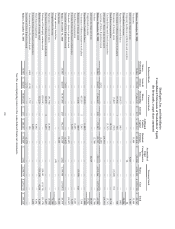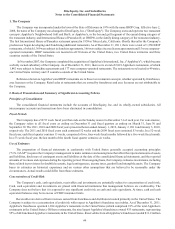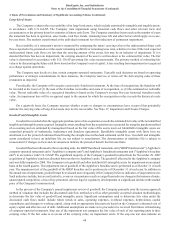IHOP 2011 Annual Report Download - page 77
Download and view the complete annual report
Please find page 77 of the 2011 IHOP annual report below. You can navigate through the pages in the report by either clicking on the pages listed below, or by using the keyword search tool below to find specific information within the annual report.59
the more-likely-than-not threshold should be recognized in the first subsequent financial reporting period in which that threshold
is met. Previously recognized tax positions that no longer meet the more-likely-than-not threshold should be derecognized in the
first subsequent financial reporting period in which that threshold is no longer met. We are subject to taxation in many jurisdictions,
and the calculation of our tax liabilities involves dealing with uncertainties in the application of complex tax laws and regulations
in various tax jurisdictions. The application is subject to legal and factual interpretation, judgment and uncertainty. Tax laws and
regulations themselves are subject to change as a result of changes in fiscal policy, changes in legislation, the evolution of regulations
and court rulings. Therefore, the actual liability for taxes may be materially different from our estimates, which could result in the
need to record additional tax liabilities or to reverse previously recorded tax liabilities.
Insurance Reserves
We use estimates in the determination of the appropriate liabilities for general liability, workers' compensation and health
insurance. The estimated liability is established based upon historical claims data and third-party actuarial estimates of settlement
costs for incurred claims. Unanticipated changes in these factors may require us to revise our estimates. We periodically reassess
our assumptions and judgments and make adjustments when significant facts and circumstances dictate. A change in any of the
above estimates could impact our consolidated statements of earnings, and the related asset or liability recorded in our consolidated
balance sheets would be adjusted accordingly. Historically, actual results have not been materially different than the estimates that
are described above.
Recently Adopted Accounting Standards
In January 2010, the Financial Accounting Standards Board (“FASB”) issued Auditing Standard Update ("ASU")
No. 2010-06, "Improving Disclosures About Fair Value Measurement" ("ASU 2010-06"). The provision in ASU 2010-06 requiring
that disclosures about purchase, sale, issuance, and settlement activity related to assets and liabilities whose fair value is measured
using Level 3 inputs be presented on a gross basis rather than as a net number became effective for us in 2011. As this provision
amended only the disclosure requirements for fair value measurements, the adoption had no impact on the our balance sheets,
statements of operations or statements of cash flows.
In July 2010, the FASB issued ASU 2010-20, "Disclosures about the Credit Quality of Financing Receivables and the
Allowance for Credit Losses." This ASU amends disclosure requirements with respect to the credit quality of financing receivables
and the related allowance for credit losses. The disclosure requirements about activity that occurs during a reporting period became
effective for us in 2011. Since this ASU only amended disclosure requirements, not current accounting practice, adoption of this
ASU did not have any impact on our balance sheets, statements of operations or statements of cash flows.
New Accounting Pronouncements
In September 2011, the FASB issued ASU No. 2011-08, Intangibles-Goodwill and Other - Testing Goodwill for Impairment
("ASU 2011-08"). The amendments in ASU No. 2011-08 are intended to simplify goodwill impairment testing by adding a
qualitative review step to assess whether the required quantitative impairment analysis that exists today is necessary. Under these
amendments, an entity would not be required to calculate the fair value of a reporting unit unless the entity determines, based on
the qualitative assessment, that it is more likely than not that its fair value is less than its carrying amount. ASU No. 2011-08 will
be effective for our fiscal years beginning after December 15, 2011; earlier adoption is permitted. As the amendments do not
change the underlying principle that the carrying value of goodwill should not exceed its implied fair value, the adoption of ASU
2011-08 is not anticipated to have a material impact on our consolidated balance sheets, statements of income or statements of
cash flows.
We reviewed all other significant newly issued accounting pronouncements and concluded that they either are not applicable
to the our operations or that no material effect is expected on our financial statements as a result of future adoption.
Item 7A. Quantitative and Qualitative Disclosures about Market Risk.
We are exposed to financial market risk, including interest rates and commodity prices. We address these risks through
controlled risk management that may include the use of derivative financial instruments to economically hedge or reduce these
exposures. We do not enter into financial instruments for trading or speculative purposes.
Interest Rate Risk
Our interest income and expense is more sensitive to fluctuations in the general level of United States interest rates than to
changes in rates in other markets. Changes in the United States Treasury-based interest rates affect the interest earned on our cash



